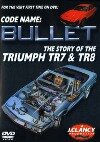Model Page
Triumph TR7

|
Produced: |
1974 - 1981 |
|---|---|
|
Production Run: |
112,368 |
|
Built: |
Speke (Sep' 1974 – May 1978) |
|
Canley (Oct' 1978 – Aug' 1980) |
|
|
Solihull (Aug' 1980 – Oct' 1981) |
|
|
Engine: |
Triumph Slant 4 1998cc SOHC |
|
0-60: |
9.6 secs |
|
Max Speed: |
111 mph |

The Triumph TR7 was arguably the most controversial TR of all time. The car was a backwards step from the TR6 in many ways with poor performance and more importantly a permanent hard top, purists saw this as a step to far. The Triumph TR7 replaced the ageing TR6, the model was not an evolution of the previous curved and swept lines of the TR6 but a complete revolution with the TR7 resembling a wedge.
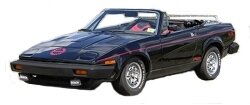
Triumph TR7 Drophead
The US was identified as being the primary market for the TR7, Market research in America indicated that the public wanted a traditional cheap to repair front engined rear wheel drive car, and the TR7 was to be marketed as a cheaper version of the Porsche 914. British Leyland had expected new regulations to be introduced into the US that would effectively ban convertible cars and so the car was only designed as a sports coupe.
Internally the car was code-named Bullett and the design was created by Harris Mann – the person responsible for the Austin Princess. Triumph engineer Spen King was charged with the development of the car, with funds severely limited by the parent company the car offered no technical surprises and utilised the slant four engine from the Triumph Dolomite mated with a four speed gearbox from the Morris Marina.
The Triumph TR7 did not have a separate chassis and body as with the previous cars in the range, but utilised a monocoque design, the platform was due to form the basis of a range of new sports cars to be developed by BL such as the still born Lynx and SD2.
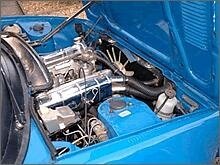
Triumph TR7 Engine Bay
BL had expected that within three years of introduction the car would include a larger engine line up including the 2.0 16 valve engine from the Dolomite Sprint and Rover V8. Although the V8 would eventually be fitted to the range, the 16v engine from the sprint was never made available. A number of prototypes were built and evaluated by management deemed that the “troublesome” engine would cause too much bad publicity for the model.
The car employed a traditional suspension setup that was not independent, Engineers identified that with the correct development and suspension setting the handling could be made comparable if not better than the cars foreign rivals. The front suspension used MacPherson struts, at the rear was a four link system with coils springs mated to a live rear axle located by radius arms. Anti roll bars were fitted to the front and rear and the braking system comprised of servo assisted solid front discs and rear drums.
The 2.0 SOHC engine offered a measly 105bhp, a huge drop of nearly a third from the outgoing TR6 that developed 150bhp, the car was released to the public after many delays and hit the showrooms in 1975. This 2.0 SOCH was available in three states of tune, the 105bhp unit available in the UK used twin SU carburettors, the 49 state tune car used twin Zenith-Strombergs and developed 90bhp but in Californian tune the engine could only muster a paltry 76bhp from its single carburettor due to emissions restrictions. Eventually all US cars were fuel injected using the Bosch L-Jetronic system.
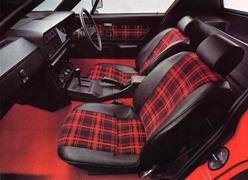
Triumph TR7 Tartan Interior
Initially the cars were equipped with a four speed gearbox, this was updated in 1977 with the five speed unit that was a far superior gearbox. Minor revisions to the car during this model year included the removal of the small British Leyland badges below the bumpers. The car was lowered by 1 inch to enhance the stance of the car and the interior was changed to red or green plaid.
The car was manufactured at the brand new Speke factory near Liverpool, workforce militancy was rife and the employees had no experience of building sports cars. Consequently the cars produced are generally considered as being of the poorest quality, the quality issues marred the cars appeal and the car developed a poor reputation. Production moved to Canley in 1978 – the cars produced at this plant were built significantly better than those at Speke and are more sought after now by enthusiasts.
The Canley TR7’s did not have many revisions, although a new steering wheel was fitted, and the bonnet now incorporated a power bulge. The FHC now came with a sunroof as standard and the car had updated instrumentation and cooling, Alloy wheels and a smart front spoiler become factory options.
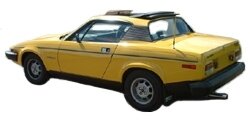
Triumph TR7 Fixed Head
By 1976, management decided that the car did in fact need to have a convertible option. Styling this new model was left to the Michelotti studio, the new convertible car was a big improvement on the FHC models from a stylist point of view. The new car was introduced to the US in July 1979, to Europe in January 1980 and the UK in the March of 1980. These convertible cars were universally praised and in the most part magazine reviews were extremely favourable. Unfortunately only 2715 of these cars were ever produced.
Solihull was the final stop for the TR7 production, revisions to the cars during this period in development included the interior being changed for plain nylon, and the fitting of a blue – grey dashboard rather than black. Metallic paint became an option and was in the most part taken up. The dashboard was updated with a quartz clock and trip odometer that was reset-able through the instrument cluster rather than under the dashboard as previously.
The Triumph TR7 was a success story bearing in mind the turmoil within the company at the time, with 112,375 cars being produced when production ended in October 1981. Values today have stabilised as the car has become accepted into classic car circles, values range considerably from less than £500 for vehicles requiring major restoration work to values in excess of £5,000 for fully restored examples.
The Facts
|
Engine: |
Triumph Slant 4 SOHC |
|---|---|
|
Capacity: |
1,998 cc |
|
Valves: |
8 |
|
Compression Ratio: |
9.25:1 |
|
Fuel System: |
Twin SU HS6 Carburettors |
|
Maximum Power: |
105bhp @ 5,500 rpm |
|
Maximum Torque: |
119lb ft @ 3,500 rpm |
|
Transmission: |
Manual 4 Speed / Manual 5 Speed |
|
Top Gear: |
4 Speed - 21.9 mph per 1000 rpm 5 Speed - 27.6 per 1000 rpm |
|
Brakes: |
Servo Assisted Vented front discs / rear drums |
|
Kerb Weight: |
1000 Kg |
|
0-60: |
9.6 secs |
|
Max Speed: |
111 mph |




